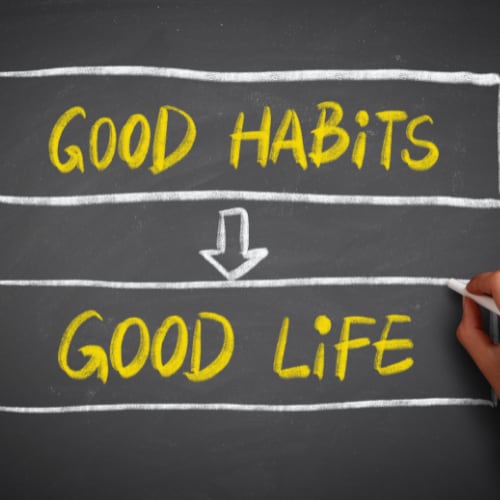 Harnessing the Power of Habits
Harnessing the Power of Habits
Harnessing the Power of Habits

-
Main Ideas
Learning Objective
Understand the habit formation process and learn strategies to develop positive habits while breaking unhealthy ones.
Behavioral Objective
Identify existing habits and implement techniques to build healthier routines that align with your wellness goals.
Key Thought
Harnessing the power of habits enables lasting change and provides a strong foundation for achieving health and wellness.
-
Main Ideas
Learning Objective
Understand the habit formation process and learn strategies to develop positive habits while breaking unhealthy ones.
Behavioral Objective
Identify existing habits and implement techniques to build healthier routines that align with your wellness goals.
Key Thought
Harnessing the power of habits enables lasting change and provides a strong foundation for achieving health and wellness.
-
Terms
- Behavior Change
noun
The process of replacing old, unwanted behaviors with new, desired behaviors through conscious effort and repetition.
- Habit
noun
Routines or behaviors performed automatically, often without conscious thought, that shape daily life and long-term outcomes.
- Muscle Memory
noun
The process by which repetitive actions become automatic through practice, often associated with physical tasks but applicable to any repeated behavior.
- Negative Habits
noun
Behaviors that have a detrimental effect on health or well-being, such as overeating, smoking, or lack of physical activity.
- Positive Habits
noun
Behaviors that contribute to long-term health and well-being, such as regular exercise, healthy eating, and stress management practices.
- Repetition
noun
The consistent performance of an action or behavior, which helps to solidify it as a habit over time.
- Trigger
noun
A cue or prompt that initiates a behavior, encouraging immediate action.
-
Terms
- Behavior Change
noun
The process of replacing old, unwanted behaviors with new, desired behaviors through conscious effort and repetition.
- Habit
noun
Routines or behaviors performed automatically, often without conscious thought, that shape daily life and long-term outcomes.
- Muscle Memory
noun
The process by which repetitive actions become automatic through practice, often associated with physical tasks but applicable to any repeated behavior.
- Negative Habits
noun
Behaviors that have a detrimental effect on health or well-being, such as overeating, smoking, or lack of physical activity.
- Positive Habits
noun
Behaviors that contribute to long-term health and well-being, such as regular exercise, healthy eating, and stress management practices.
- Repetition
noun
The consistent performance of an action or behavior, which helps to solidify it as a habit over time.
- Trigger
noun
A cue or prompt that initiates a behavior, encouraging immediate action.
Introduction
Habits are the foundation of daily life, shaping our actions, health, and future. Understanding how habits are formed and learning to replace harmful ones with healthier behaviors can create lasting, positive changes. This topic explores the science of habits, offering practical strategies to harness their power, so you can design a lifestyle that supports your health and wellness goals effectively and sustainably.
The Science of Habits
Habits are automatic behaviors driven by repeated actions and environmental cues. Once formed, they require little effort or conscious thought, making them powerful tools for change-or barriers to progress. Understanding how habits work allows us to identify patterns and intentionally shape them for better outcomes.
The Habit Loop
Habits operate in a loop consisting of three components:
- Cue: A trigger that initiates the behavior.
- Routine: The action or behavior itself.
- Reward: The benefit or satisfaction derived from the behavior.
For example, feeling tired (cue) might lead to drinking coffee (routine), providing an energy boost (reward). By recognizing this loop, we can adjust the routine or rewards to create healthier habits.
Building Positive Habits
Start Small
Big changes can feel overwhelming. Instead, focus on small, manageable steps that build momentum over time. For instance, if you want to start exercising, begin with a five-minute walk daily and gradually increase your duration as it becomes a habit.
Anchor New Habits to Existing Routines
Connecting a new habit to an established one makes it easier to remember and sustain. For example, if you want to drink more water, associate it with an existing habit like brushing your teeth or preparing meals.
Breaking Unhealthy Habits
Identify Triggers
Unhealthy habits often stem from specific cues. By identifying these triggers, such as stress or boredom, you can disrupt the habit loop and replace it with healthier alternatives. For example, replace stress-eating with a short walk or breathing exercises to reduce tension.
Design a Supportive Environment
Creating an environment that reinforces good habits and minimizes temptations is important. Keep nutritious snacks visible and within reach while removing unhealthy options from your home or workspace.
The Role of Consistency
Consistency is the key to making habits stick. Research suggests it takes 21 to 66 days for a new behavior to become automatic. While this timeline varies, the principle remains the same: repetition strengthens habits. Even small daily actions can lead to significant long-term changes.
Celebrating Progress
Recognizing and celebrating small wins keeps you motivated and reinforces positive habits. Acknowledge your efforts, no matter how small, to maintain momentum and encourage further growth.
Harnessing the Power of Habits Quiz
Ready to turn routines into results?
Harnessing the Power of Habits challenges your knowledge of habit loops, muscle memory, repetition strategies, and techniques to build positive habits while breaking negative ones. Ten targeted questions with instant feedback will help you identify triggers, design supportive environments, and leverage consistency and celebration tactics. Complete the quiz to unlock a personalized Remediation Map packed with habit-building insights.
Identifying Your Current Habits
Objective: Recognize the habits that are currently shaping your daily life and evaluate their impact on your health and well-being.
- Write down a list of your daily habits, both positive and negative (e.g., morning routine, eating habits, exercise, screen time).
- Next to each habit, note whether it contributes positively or negatively to your overall health and goals.
- Choose one negative habit that you would like to replace with a positive one and identify a small first step to start changing it.
Building a New Habit
Objective: Learn how to establish a new, positive habit through consistency and repetition.
- Choose one positive habit you want to build (e.g., walking for 15 minutes, drinking more water).
- Commit to practicing this habit every day for the next two weeks.
- Track your progress in a journal or app, noting how you feel each day after completing the habit.
- After two weeks, reflect on the progress you've made and adjust your plan if necessary to keep building the habit.
Reprogramming an Old Habit
Objective: Replace a negative habit with a positive behavior that better serves your health and well-being.
- Identify a habit that no longer serves you (e.g., eating unhealthy snacks late at night).
- Choose a positive behavior to replace it (e.g., drinking herbal tea or reading a book before bed).
- For the next week, every time you feel the urge to engage in the old habit, substitute it with the new behavior.
- Record how this change makes you feel physically and emotionally and assess your progress at the end of the week.
Anchor a New Habit
Objective: Link a positive habit to an existing routine to ensure consistency.
- Identify a habit you want to build and an existing routine it can follow.
- For one week, practice adding the new habit to the existing routine.
- Reflect on how this anchoring technique makes habit formation easier.
Create a Supportive Environment
Objective: Design your surroundings to reinforce good habits and reduce temptations.
- Remove obstacles to positive habits, such as clutter or distractions.
- Add visual reminders, like notes or objects, to trigger desired behaviors.
- Evaluate how your environment influences your habits and make adjustments as needed.
Course Outline
![]() Session Expired from Inactivity
Session Expired from Inactivity
Do you want to?
9618 Jefferson Highway, Suite D-191
Baton Rouge LA 70809-9636
(888) 424-0032 |
support@supplementrelief.com
* Disclaimer: This page is available exclusively for SupplementRelief.com clients. None of the information on this website is intended to replace your relationship with your healthcare provider(s). Nothing should be considered medical advice. The information, knowledge, and experience shared on this website are the opinions of SupplementRelief.com. This site and its content are intended to enhance your knowledge base as YOU MAKE YOUR OWN HEALTHCARE DECISIONS in partnership with your qualified health professional.
* These statements have not been evaluated by the Food and Drug Administration. These products and services are not intended to diagnose, treat, cure, or prevent disease.
* There is NO GUARANTEE OF SPECIFIC RESULTS for the products or services offered, and the RESULTS CAN VARY for each individual. Any results claimed by our customers are based on individual experiences that are unique and cannot be guaranteed.
FirstFitness Nutrition and NuMedica may be promoted and sold on the internet ONLY by Authorized Resellers who have been approved by and have registered their website domain with these companies. They strictly prohibit, and actively monitor, the UNAUTHORIZED SALE or RESALE of their products in ALL online public shopping portals including Amazon, eBay, and others and into other countries. All products purchased in SupplementRelief.com are for PERSONAL USE ONLY and CANNOT BE RESOLD to others. Please report violations of Reseller Policy directly to FirstFitness Nutrition at 800.621.4348 and to NuMedica at 800.869.8100.
The content and photographs on this website are copyrighted or Licensed Material and may not be downloaded for other than personal use. Republication, retransmission, reproduction, or any other use of the content or photographs is prohibited. ©2010-2024 SupplementRelief.com.
Are you sure you want to remove this item?


